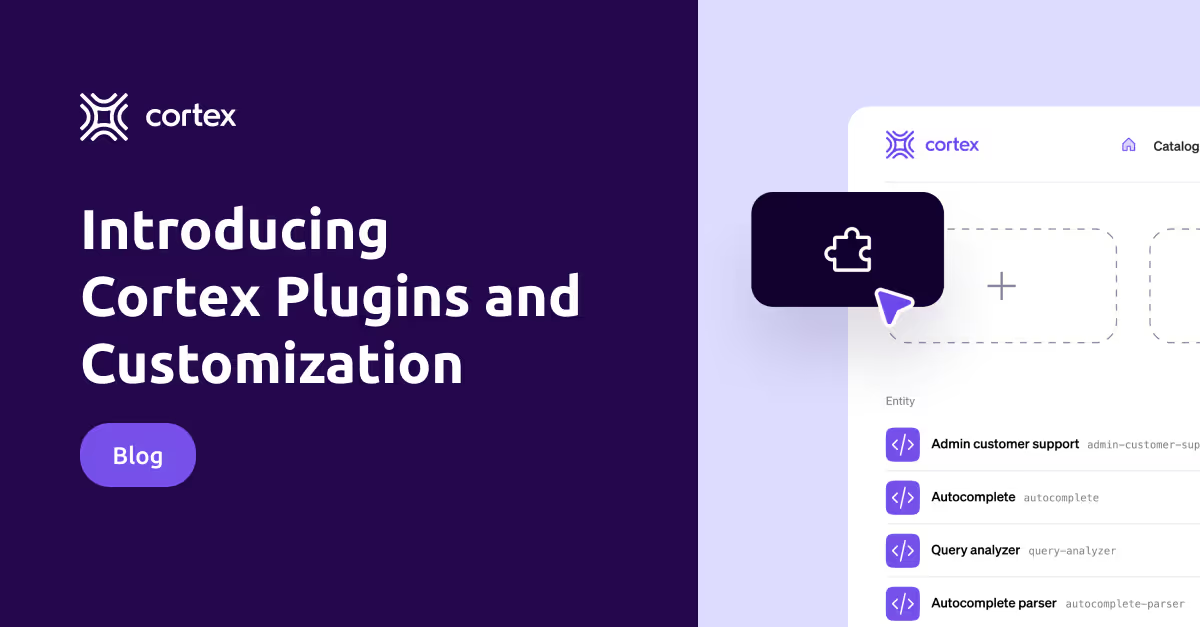Introduction
To be a true system of record, your IDP needs to be a source of truth for all the data in your stack. While Cortex offers 50+ out of the box integrations, and the ability to bring in custom data, we know there are occasions where you’ll also want to visualize or take action on data sourced from other places including internally developed tools or repositories. That’s why we’re excited to officially launch the Cortex plugin framework plus UI customization. Now users can:
Bring data from anywhere including homegrown tools or databases to ensure a comprehensive system of record
Expose custom metrics like cost insights or security posture
Reduce “clicks to value” with shortcuts to adjacent systems. e.g. deploy to Jenkins from the Cortex UI
Customize the Cortex UI to match workflows from other tools your devs love. Embed plugin widgets on the homepage, catalog entity pages, or sidebar navigation, and change the order of existing tabs
How plugins work
Let’s say developers want more context from tooling related to incident management workflows, vulnerability scanning software, or even deployment tasks in order to make decisions in Cortex—but you don’t want them to have to toggle between multiple applications to get that information.
Cortex’s plugin framework enables you to create widgets or iframe experiences that you can append to the Developer Homepage navigation bars, or within each service or resource detail page. Bring more data to where your devs are already working, and enable them to take action quickly.
1. Create a new plugin
Cortex makes it easy to spin up a new plugin repository using the Scaffolder tool. This template is already available for use in Cortex and spins up a new repository with a basic setup for each.
2. Register your plugin
To register your plugin with Cortex, click Plugins in the main header and "Register plugin" to enter the plugin registration flow. You'll be asked to fill out some basic metadata about the plugin as well as upload the file containing your plug in HTML.
3. Set permissions and locations
Once you've created and registered your plugin, you can set minimum role level access, and include or exclude groups from viewing the plugin. You can also determine which entities (service, resource, domain, or team) your plugin will be appended, and where in the navigation your plugin will appear.
4. Iterate on your plugin
Cortex makes it easy to iterate on your plugin with a "dev mode" toggle on the create and edit plugin page and a "dev" script in the Scaffolded plugin repository.
For more information on how to get started with Cortex plugins, visit our docs page.
Top plugin examples
Whether bringing data from internal sources, extending data available from our out-of-the-box integrations, or even leveraging tooling we don't yet have an integration for, Cortex plugins enable you to be the Chief Experience Office for your IDP program.
Cortex customers with advanced access to plugins have already started building for a variety of these scenarios; here’s just a sample of what we’ve seen to date:
Deployment Dashboard: An interactive dashboard that provides deployment details and frequency to your Cortex UI. In addition to having more context on changes, users can also deploy straight to Jenkins through the interface.
Cost Insights: Enables teams to easily visualize the cost footprint of each service relative to overall cloud spend, and use that data as part of their operational review.
Vulnerability Details: Displays the full results of vulnerability scanning software within the Cortex UI so engineers can see full context about vulnerabilities relevant to services they own, without needing to switch between applications to complete their analysis.
Google Form: Enables managers to collect feedback from the team related to projects, programs, and initiatives right from within Cortex.
Current Context: Enables users to view the raw JSON value of the context including location, tag, type, etc.
GitHub Issues: Enables users to view issues in Github for a given repo, as well as the state they’re in.
GitLab Registry: Enables users to view all the images and tags in their GitLab project.
ServiceNow Incidents: Enables users to view ServiceNow incidents associated with a given service in Cortex.
Cortex UI Customization
The plugins framework also enables us to offer greater UI customization. Not only can you embed your plugin on various menus and pages throughout the Cortex UI, you can also change the appearance of those navigation menus.
Now users can add plugins to the top-line header navigation, Dev Homepage navigation, and entity page side navigation.
Users can also now change the order, naming and appearance of existing header, side view, and entity overview tabs.
Building with Cortex
Future-proof your IDP while increasing productivity with plugins and customization to support any use case and data source. Reduce context switching for engineers, and make it faster and easier to take action. Ready to dig in? Check out our quick 3-min video, or our plugins documentation. Ready to get started with Cortex? Get in touch with our team to learn how Cortex can help support your journey to engineering excellence.











